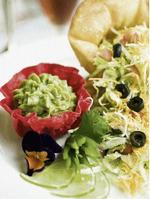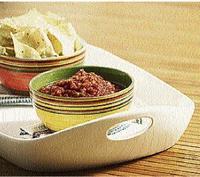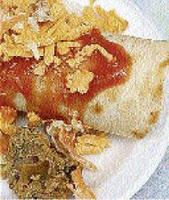Heather Little-White, Contributor 
When you think of Mexican food, what comes to mind? You may think of tacos, tamales, enchiladas and salsas. Sally, who loves Mexican food, says, "A plate with a combination with an enchilada, deep-fried taco, overstuffed burrito and refried beans is a culinary treat to die for."
Mexican cuisine offers renowned fare, even expanding to the Tex-Mex fast food, high in fat and low in fibre. Healthy Mexican food is consumed more regularly today by the average health-conscious consumer. There is a new world of healthy Mexican cuisine where grilled meats and seafood take centre stage and sauces are a delectable blend from fruits and vegetables.
New research has indicated the native Mexican food is good for your health. In a study at the University of Texas Health Center, published in the American Journal of Clinical Nutrition, comparisons were made with women diagnosed with cancer and those not diagnosed to determine if the dietary patterns made a difference in the outcome of cancer. The results showed that pre-menopausal women who ate Mexican foods such as cheeses, beans, soups, tomato-based sauces and meats experienced protection against breast cancer.
High-quality protein

Nachos and a tasty dip.
Mexican staple foods such as tortillas, beans, and rice are excellent sources of complex carbohydrates. Adequate protein is obtained from moderate portions of meat, fish and poultry. Rice and beans and beans and tortillas - when eaten together - supply high-quality protein. Healthy ingredients that make native Mexican food are everyday foods that are readily available. These include tomatoes, cabbage, corn, beans and squash.
If you love avocados, you should love the popular Mexican dish - guacamole made from avocados, tomatoes, cilantro and lime juice. Guacamole is usually a dip but it can be used to fill tacos, enchiladas and may even top toast or crackers for a quick snack.

Guacamole
Guacamole with avocados as the main ingredient provides vitamins and minerals with 'good fats' that allow the body to absorb more beneficial plant nutrients, such as alpha-carotene, beta-carotene, lycopene and lutein found in fruits and vegetables. It is best to use high-quality avocados and vine-ripened tomatoes. Avocados and tomatoes are excellent for the skin and they help to reverse the ageing process.
You may be concerned about the extra fat and high calories in Mexican food but with some tweaking, you can adjust native recipes to allow you to enjoy low-fat Mexican fare. The rich heritage of Mexican cooking uses lard and bacon but there are ways for you to cook healthy Mexican food at home. As with all cuisines, some dishes are healthier than others. The first step is to choose those dishes that are healthy. Healthy dishes now offered in restaurants include Veracruz-style seafood dishes cooked in herbed tomato sauce or chile verde, a pork dish simmered with vegetables and green chilies.
Salsa
Salsa, another highly recommended nutritious condiment bursting with flavour, can accompany a number of foods, especially fish. Salsa complements Mexican food beautifully and is the best-selling condiment in North America, ahead of tomato ketchup. Fruit salsas - mango, pineapple and cranberry - are a sweet contrast for a spicy dish and regular salsas are great with pastas.
Regular salsa is made from fresh ingredients of vegetables like bell peppers, tomatoes, corn, pineapple, onion, garlic, peppers and any other vegetables of your choice. The versatility of salsas is unmatched - they can be placed on top of eggs at breakfast, stirred into sautéed vegetables, mixed with pasta, served as hot dog relish, used in salads, be placed atop baked potatoes and accompany corn chips as a snack.
Phytochemicals
Phytochemicals and antioxidants come in abundance in salsas. More than 900 phytochemical compounds are found in fresh fruits and vegetables and help to prevent cancer, diabetes, cardiovascular disease and hypertension. The promotion of five fruits and vegetables every day is a prevention strategy to boost your phytochemicals and antioxidant intake each day.
Refried beans

The burrito is a Mexican favourite.
Contrary to the name, refried beans are popular in native Mexican fare. To make this dish healthy, the lard would have to be omitted. Bacon oil is preferred to canola oil to get the best taste. Further, it is advisable to use roasted garlic and sea salt to add to the taste, simmering beans as long as possible to maximise flavour. Refried beans can be eaten on their own, but in true Mexican style are more delectable with rice or enchiladas.
Healthy choices
4 Request soft taco instead of crispy, fried taco.
4 In ordering a taco salad, ask the chef to go easy on the big fried Tortilla shell or the taco chips.
4 For entrées, choose mostly baked or stir-fried entrées, such as enchiladas or fajitas. Be careful of fried main-course dishes.
4 Black beans are available whole and not fried in lard.
4 Go easy on nachos and cheese.
4 Red beans and rice, chicken and rice and Spanish rice are healthy choices for children.
4 When dining out, look for menu descriptions that suggest less fat - asada (grilled), simmered, tomato sauce, picante, wrapped with soft tortilla and served with salsa verde (green chile sauce).
4 Low-fat appetisers include gazpacho (cold tomato soup), jicama and salsa, tortilla or black bean soup.
4 Mexican food is normally served in large portions, so choose regular plates and not the 'deluxe combo' plate.
Heather Little-White, PhD, is a nutrition and lifestyle consultant in the Corporate Area. Send comments to: saturdaylife@gleanerjm.com or fax :922-6223.

